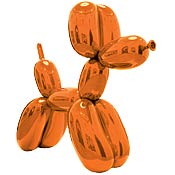
Countless artists today work with kitsch. It’s taken for granted as a subject, as conventional in its way as still-life or landscape painting. Unfortunately, critics and viewers usually treat this tradition in either-or terms. If you love the idea of an Elvis sighting, then you will enjoy art that works with kitsch. If you don’t, you may find it vapid and, possibly, a sign of cultural decadence. Such responses make little sense. Kitsch is such a powerful presence in America that, inevitably, artists try to confront and transform it. Their work, like art that depicts a still-life or landscape, can be more or less competent and can embody many different attitudes, from the silly to the sublime.
Jeff Koons is a razzle-dazzle impresario of the kitsch object, Cindy Sherman an explorer of clichéd roles and social disguises. They are very different artists, but their approach to the kitschy illustrates the characteristic strengths—and, at times, the principal weakness—of this tradition. Koons is now the subject of a concise retrospective at C & M Arts, while an intriguing show of Sherman’s earliest, heretofore unexhibited work, organized by Gail Stavitsky, is now at the Montclair Art Museum. And some of Sherman’s recent photography is on view at Metro Pictures and at the fashion-photography exhibit at MoMA QNS.
The main weakness of the tradition is an attitude of campy superiority, one that can quickly become self-congratulatory. For example, Sherman’s lampooning of a fashion shoot, especially her shot of a grotesque model with dirty socks, is memorably funny. But the target is easy. Similarly, Koons’s photographs of himself having sex with the Italian porn star Cicciolina—porn, of course, is kitsch—represent too easy a brag about “transgression” and “narcissism.” Mocking a corny found image of an armful of puppies, as Koons does, is also an easy score. Art about kitsch can itself become a form of intellectual kitsch, filled with sloppy, unearned emotion.
“Powerful, even angry sensations of lost innocence shape the work of both artists.”
In their best art, Koons and Sherman do something riskier and more paradoxical, entering into the spirit of kitsch as if to know it from the inside. They both retain, in such work, something youthful or childlike. In 1975, Sherman, while still an art student, made a series of 23 hand-colored black-and-white photographs—they look like they were taken in a photo booth—that show her slowly transforming herself, step by step, from an earnest, dowdy girl into a vampy babe with a cigarette. The work is an unsentimental comment on gender roles, of course, but it’s not only that. It simultaneously captures, poignantly, the play of adolescent dreaming. Koons’s celebrated Rabbit—sometimes nicknamed the Brancusi Bunny—is not simply a parody of kitsch, Brancusi, and minimalism. His Bunny is equally an awestruck homage to all of them. As a result, it’s delightfully unsettling, an invitation to reconcile the irreconcilable.
Powerful, even angry sensations of lost innocence—something not usually attributed to hip and knowing postmodernists—shape the work of both Koons and Sherman. Koons’s childish figures have a fussed-over finish that looks careful, still, and seductive, as if they had been embalmed. Certain of his objects could almost be funerary monuments. Sherman’s clowns at Metro Pictures are neither the melancholy funnymen of modernism nor the Ronald McDonald idiots of kitsch; instead, they are adults mired in a candied rainbow world. If Sherman once played dress-up with her mother’s clothes, now she rages through the American closet, assuming and throwing away identities.
Much of the best art of this kind has a delirious, hallucinatory air, as if the artist were trying to transcend both the naïveté of junk feeling and the sophistication of the art world. Koons’s Michael Jackson and Bubbles is a porcelain-and-gold mirage of the entertainer who has not only become the gold standard of kitsch but also transformed himself into a living hallucination. The showstopper at the Koons exhibit is a cousin of the Brancusi Bunny called Balloon Dog (Orange), an astonishing stainless-steel apparition of monstrous size that seems about to float away, like a bizarre blimp, into a parallel universe just beyond the American horizon.